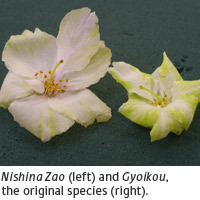Nishina Zao

Particle accelerators are best-known for the central role they play in uncovering the fundamental dynamics and structure of matter, space and time, but they have other uses as well. Over the past several years, researchers at the RIKEN Nishina Center for Accelerator-Based Science have developed an application for such accelerators that goes well beyond the experimental physics for which they were originally designed. In an approach unique to Japan, seeds from a variety of different plants are exposed to beams of heavy atomic ions accelerated to half the speed of light, producing mutations and breeding new varieties of flowers, crops and trees.
There are many advantages to this new approach. In contrast to other breeding techniques such as hybridization, exploration and gene recombination, the time span for breeding with heavy-ion beams can be shortened to only two or three years. Heavy-ion beams also carry much greater energy than the X-rays and gamma rays used in mutation induction (mutagenesis), meaning that a gene can be significantly altered even with only a single particle. The high-performance of RIKEN accelerators also enable the use of ions of carbon, nitrogen, neon, argon, iron, and other elements, thus offering a greater variation in the types of mutations.
A high-profile example of the new varieties of plants generated from this method is the Nishina Zao, a strain of cherry blossom with pale yellow flowers. Using the RIKEN Ring Cyclotron at the RI Beam Factory (RIBF) in the Nishina Center, a group led by Deputy Laboratory Head Dr. Tomoko Abe, in collaboration with the Japan Flower Culture (JFC) Ishii Farm, induced mutations in cuttings from Gyoikou cherry trees in Yamagata Prefecture, which have a mixture of yellow and green blossoms. This led to the creation of a new strain, the first plant to be registered by RIKEN under the Seeds and Seedlings Law.
The name of the new flower symbolizes its origins. Nishina is the surname of the father of accelerator-based science in Japan, Yoshio Nishina. Zao is the name of a mountain in Yamagata Prefecture where the co-researcher in the project lives. Once created, the Nishina Zao plants were taken back to mount Zao to be grown, where they blossomed in the spring.
